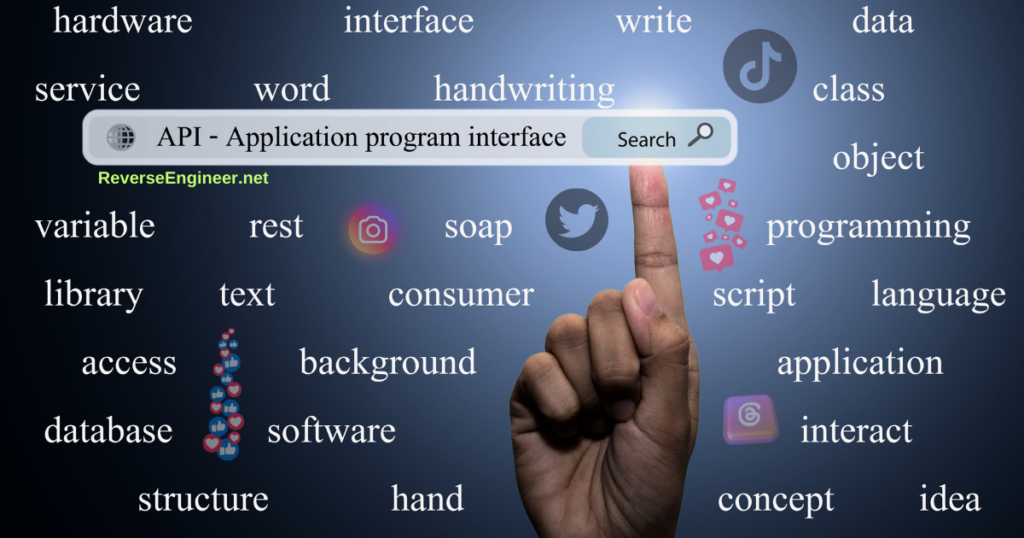
Introduction to API Reverse Engineering
API reverse engineering entails the process of dissecting an application programming interface (API) to understand its internal functionalities, architecture, and communication patterns without prior knowledge or documentation. This practice is prevalent among developers who seek to create compatible applications, improve interoperability, or simply understand how existing systems operate. Reverse engineering can be particularly useful when dealing with undocumented APIs, such as those commonly found in social media platforms like Instagram.
The necessity for API reverse engineering arises from various motivations. For instance, developers may wish to integrate additional features into existing applications or create entirely new tools based on the functionality exposed by an API. Additionally, understanding undocumented APIs can provide valuable insights for debugging purposes or when seeking to enhance application performance. In the age of digital transformation, where social media platforms are paramount in communication and marketing strategies, comprehending their underlying APIs can unlock opportunities for innovation and improved user experiences.
However, the ethical and legal implications of engaging in reverse engineering cannot be overlooked. Many platforms’ terms of service explicitly prohibit unauthorized access or manipulation of their APIs, which can lead to legal ramifications for developers. It is essential to approach reverse engineering with caution, ensuring compliance with applicable laws and platform guidelines. Furthermore, ethical considerations should drive developers to respect the intellectual property of organizations while aspiring to create tools that comply with established standards. Understanding these nuances is critical before embarking on any reverse engineering endeavors, particularly in contexts where platform-specific regulations are stringent, as seen with Instagram.

Understanding Instagram’s API Landscape
Instagram provides several API frameworks aimed at enabling developers to integrate and interact with the platform programmatically. The most prominent among these is the Graph API, which serves as the primary method for accessing Instagram data. This API allows developers to retrieve user information, media, comments, and insights, enabling the creation of applications that leverage this rich set of functionalities. The Graph API is largely focused on business accounts and provides robust tools for actions like managing ad campaigns, measuring performance, and accessing analytics.
In addition to the Graph API, Instagram also offers the Basic Display API, which provides a limited set of functionalities for personal accounts. This API facilitates the retrieval of user profile information and media, but does not support features such as the ability to post content or manage comments. Consequently, developers aiming to harness the full potential of user engagement face inherent limitations when relying solely on the Basic Display API.
However, a more complex landscape exists with undocumented APIs that some developers try to use. These undocumented interfaces often provide more extensive functionality and allow access to a variety of features that are not accessible through official endpoints. Furthermore, the instability of undocumented APIs poses a challenge as they can be changed without notice, making long-term projects that depend on them impractical. The hurdles faced when trying to interact with Instagram programmatically are significant, as it involves overcoming both the official limitations of sanctioned APIs and the dangerous nature of unauthorized methods.

Technical Challenges in API Reverse Engineering
API Reverse engineering for Instagram presents a number of significant technical challenges for engineers to overcome. When embarking on the reverse engineering process, the first hurdle that is often encountered is data encryption. Many undocumented APIs use complex encryption methods to protect their data exchanges. The type of encryption methods used is very important and can vary all the time. However, it is impossible to access, use, and replicate these APIs without bypassing these encryption methods.
Understanding and potentially decrypting these encryption techniques requires advanced cryptography knowledge and the ability to use specialized tools in traffic analysis. ReverseEngineer.net Reverse Engineers specialize in both advanced cryptography and encryption methodologies to uncover private APIs. We have previously conducted similar work on Instagram, TikTok, and Snapchat.
Another significant challenge is interpreting the data structures. The data returned by an API is formatted in a variety of styles, including JSON or XML. It is crucial for reverse engineers to understand the context of the information by correctly mapping these structures. This task requires real expertise, especially since undocumented APIs can provide responses that lack proper documentation. Familiarity with different data serialization formats and experience with the relevant programming languages are important skills to successfully interpret these structures.
Authentication mechanisms introduce additional complexities. An undocumented API often lacks general strategies for user authentication. In Instagram’s case, the process involves token-based authentication or session management techniques that need to be understood and replicated. Again, our expert staff can help you overcome these challenges and bypass authentication mechanisms altogether.
Finally, rate limiting is a fundamental aspect of API design that can hinder reverse engineering efforts. Instagram may impose limits on the number of requests that can be made in a given time period to prevent abuse. Understanding these restrictions is important for efficient discovery without encountering blockages or bans. Again, our Reverse Engineers provide appropriate and cost-effective custom proxy solutions, and we achieve a 100% success rate here.

Methods for Discovering API Endpoints
Reverse engineering undocumented social media APIs, such as Instagram’s, often requires a multifaceted approach to uncover their hidden functionalities. Various techniques and tools can assist developers in discovering API endpoints that are not formally documented. One of the most effective methods is network traffic analysis, where developers monitor the data sent and received by the application during its operation. Tools such as Wireshark or Fiddler allow users to capture and inspect network packets, revealing the API calls made by the app. By analyzing these packets, developers can understand the parameters required, the structure of requests, and the expected responses.
Another valuable technique is the use of intercepting proxies. Tools like Burp Suite and Charles Proxy serve as intermediaries between the client and server, allowing developers to view and manipulate API requests and responses in real-time. These proxies enable users to modify headers, query parameters, or even payload data, providing insights into how the Instagram application interacts with its server. By replaying requests, developers can experiment with different inputs and potentially discover undocumented functionalities within the API.
Creating Authentic API Calls: From theory to practice
When reverse engineering an undocumented social media API, such as Instagram’s, it is essential to construct authentic API calls that closely resemble those made by the official client. This process begins with proper authentication, as many APIs require a valid token or key to access their endpoints securely. There are various authentication methods such as OAuth2, API keys, and bearer tokens, each of which serves to validate a user’s credentials and ensure secure communication with the server.
The next crucial component is the header structure. An API call typically requires several headers to be included to inform the server about the nature of the request. These headers may consist of content type declarations, authorization tokens, user agent strings, and custom headers identified during the reverse engineering process. Properly mimicking these headers is vital to avoid detection and ensure that your requests are handled just like those from official clientele.
Furthermore, the payload structure is equally significant for API calls. Depending on the action being performed—such as retrieving user data or posting content—the payload may need to include a variety of parameters or data fields. Understanding the expected format, which could be JSON or form-data, plays a crucial role in constructing valid requests. Analyzing successful request examples from the official API can provide insight into the required fields and their respective formats, enabling the replica of requests accurately.
Additionally, incorporating rate limits and timeout periods can help prevent the server from flagging your API calls as suspicious. Respecting these limitations ensures continuity and longevity of access, which is vital for any integration relying on undocumented endpoints. In this dynamic landscape, keeping track of active requests and responses allows for adjustments, refining efficiency and compliance with the server’s expected interaction patterns.

Case Studies: Successful API Reverse Engineering
Reverse engineering of undocumented APIs has become one of our areas of expertise and we have achieved many successful projects to date.
In one of our prominent cases, we worked with a group of clients who wanted to integrate advanced features of Instagram into their own applications. We revealed private API calls and parameters by deeply analyzing the network traffic of the Instagram application. In this way, we successfully integrated basic features such as uploading photos and posting comments, as well as additional functions that were not yet available in Instagram’s own application. As a result of these efforts, our client was able to create a third-party application that enriched the user experience and made a difference in the industry. We continuously overcame the technical challenges created by regular updates to the Instagram infrastructure and provided permanent and sustainable solutions.
Another important success story was with a technology startup that provides data analysis services for social media influencers. We obtained extensive user interaction data for our client who wanted to go beyond the limitations of Twitter’s official API through reverse engineering. We developed a custom API layer that analyzes network requests and responses and provides real-time and detailed data. This solution helped social media influencers manage their content strategies more effectively and increased the startup’s competitiveness in the industry. Throughout the project, we constantly considered compliance with platform rules and created flexible solutions that quickly adapted to Twitter’s security updates.
These case studies are a strong proof of the potential of reverse engineering undocumented social media APIs. With creative solutions and meticulous research processes, we continue to deliver value to our customers that will make a difference in the industry.
If you have similar projects, you can contact us.
Our expert Reverse Engineer team will hold a detailed meeting with you and then we will send you our price offer and estimated delivery time. We are always open to working with you under suitable conditions.
Conclusion and Future Outlook
In this discussion on reverse engineering undocumented social media APIs, specifically focusing on Instagram’s API calls, several critical points have emerged. First, the feasibility of reverse engineering such APIs hinges on a mixture of legal, ethical, and technical considerations. While developers may find ways to access and utilize undocumented API functionalities, this practice can pose significant risks, including potential violations of terms of service and user privacy concerns. The ever-evolving nature of social media platforms means that what is accessible today may not be tomorrow, as companies like Instagram regularly update their APIs to safeguard against unauthorized access.
Furthermore, the implications of reverse engineering in the tech industry spark notable discussions around transparency and user privacy. As users become increasingly aware of the data they share, there is a corresponding call for platforms to maintain open communication regarding their API functionalities and data handling policies. This is especially pertinent given the rise of privacy regulations around the globe, which demand greater accountability from tech companies regarding user data management.
Looking to the future, the landscape of social media APIs may shift toward greater transparency. Organizations might be more inclined to develop robust, publicly accessible APIs that allow developers to build applications without resorting to reverse engineering. This approach could mitigate the ethical challenges associated with unauthorized access while fostering innovation in the tech ecosystem. As Instagram and similar platforms adapt to changing user expectations, the role of developers will also evolve, balancing the desire for access with the need to respect user privacy and adhere to evolving regulations.
Let's Work Together
Need Professional Assistance with Reverse Engineering or Cybersecurity Solutions? Our Team is Ready To Help You Tackle Complex Technical Challenges.